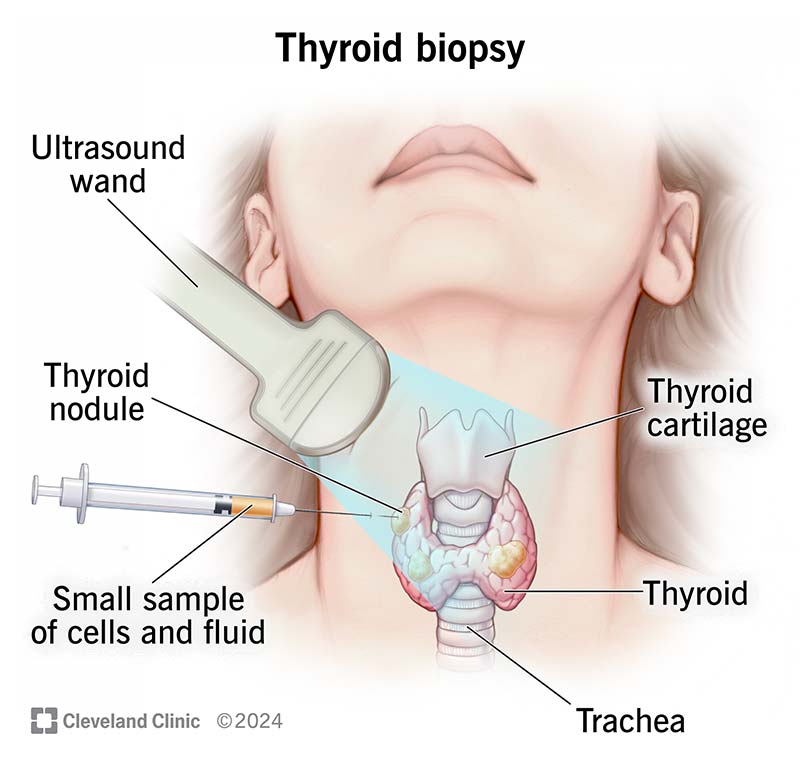A thyroid biopsy is a test your healthcare provider might recommend if you have thyroid nodules (bumps on your thyroid). During the procedure, a provider collects a small sample of cells and fluid from the nodule. Then, they send the sample to a pathology lab for testing.
Advertisement
Cleveland Clinic is a non-profit academic medical center. Advertising on our site helps support our mission. We do not endorse non-Cleveland Clinic products or services. Policy

A thyroid biopsy is a procedure that removes a small sample of cells and fluid from your thyroid gland. Healthcare providers use it to help diagnose certain thyroid conditions.
Advertisement
Cleveland Clinic is a non-profit academic medical center. Advertising on our site helps support our mission. We do not endorse non-Cleveland Clinic products or services. Policy
You don’t need a biopsy to diagnose all thyroid conditions. In many cases, a blood test and imaging results are enough. But your healthcare provider might recommend a thyroid biopsy if you have thyroid nodules. Thyroid nodules are small solid or fluid-filled bumps that can form in your thyroid gland. Most nodules are benign (noncancerous), but some (around 5% to 15%) can be malignant (cancerous).
A thyroid biopsy can help your provider find out what caused a nodule. Healthcare providers are more likely to biopsy nodules that are larger than 1 centimeter (0.39 inches).
Healthcare providers do thyroid biopsy procedures in one of three ways:
Advertisement
Preparation depends on the type of thyroid biopsy:
Thyroid needle biopsy (FNA or CNB)
Unless your provider tells you otherwise, you should be able to eat and drink normally before your appointment. But it’s a good idea to ask whether you should stop taking any medications in the days leading up to your procedure.
Surgical thyroid biopsy
If you’re having a surgical thyroid biopsy, your provider will give you instructions on how to prepare.
Your healthcare provider is the best person to tell you how to prepare for your thyroid biopsy. Be sure to ask them if you have any questions.
In most cases, providers use FNA or CNB to do a thyroid biopsy. But in rare instances, they may need to do a surgical biopsy. Listed below are the steps to each.
Thyroid needle biopsy (FNA or CNB)
These are typically outpatient procedures, meaning you’ll go home the same day. Your provider will:
Your provider might repeat this process if you have more than one nodule. The procedure takes about 10 to 20 minutes to complete.
Surgical thyroid biopsy
This approach is very rare. But a provider may need to do a surgical biopsy if results from your FNA or CNB aren’t clear, or if they need additional information.
The procedure involves removing nodules and/or tissue samples directly from your thyroid gland and sending them to a lab for testing.
Common thyroid biopsy side effects include soreness and bruising at the injection site. You can manage any discomfort with over-the-counter (OTC) pain relievers like acetaminophen (Tylenol®) or ibuprofen (Motrin®).
Complications are rare. But they can include:
According to the American Thyroid Association, there are six possible biopsy results. The following chart explains what each one means.
| Thyroid biopsy results | What the results mean |
|---|---|
| Benign | The nodule is noncancerous. About 70% of all thyroid biopsy results come back as benign. |
| Malignant | The nodule is cancerous. About 3% to 7% of all thyroid biopsy results come back as malignant. |
| Suspicious | There’s a 60% to 75% chance that the nodule is cancerous. |
| Atypia of undetermined significance (AUS) | The nodule has both benign and malignant characteristics. About 5% to 15% of these nodules are cancerous. |
| Follicular neoplasm | It’s hard to tell if the nodule is benign or cancerous unless surgically removed. About 15% to 30% of these nodules are cancerous. |
| Nondiagnostic | This result means that there aren’t enough cells in the sample to make a reliable diagnosis. |
| Thyroid biopsy results | |
| Benign | |
| What the results mean | |
| The nodule is noncancerous. About 70% of all thyroid biopsy results come back as benign. | |
| Malignant | |
| What the results mean | |
| The nodule is cancerous. About 3% to 7% of all thyroid biopsy results come back as malignant. | |
| Suspicious | |
| What the results mean | |
| There’s a 60% to 75% chance that the nodule is cancerous. | |
| Atypia of undetermined significance (AUS) | |
| What the results mean | |
| The nodule has both benign and malignant characteristics. About 5% to 15% of these nodules are cancerous. | |
| Follicular neoplasm | |
| What the results mean | |
| It’s hard to tell if the nodule is benign or cancerous unless surgically removed. About 15% to 30% of these nodules are cancerous. | |
| Nondiagnostic | |
| What the results mean | |
| This result means that there aren’t enough cells in the sample to make a reliable diagnosis. |
Most people receive their biopsy results within one week.
Your healthcare provider will let you know what your results mean and whether you need treatment.
Each case is unique, but here’s a general idea of what to expect:
Advertisement
After your thyroid biopsy, let your healthcare provider know if you develop signs of infection like:
“Biopsy” can feel like a scary word. But needing a thyroid biopsy doesn’t mean there’s something wrong. Just like X-rays and blood tests, biopsies are tools that healthcare providers use to diagnose conditions — and the results deliver key information. Detecting thyroid issues before they get worse gives you the best chance for long-lasting health.
Advertisement
Last reviewed on 06/28/2024.
Learn more about the Health Library and our editorial process.